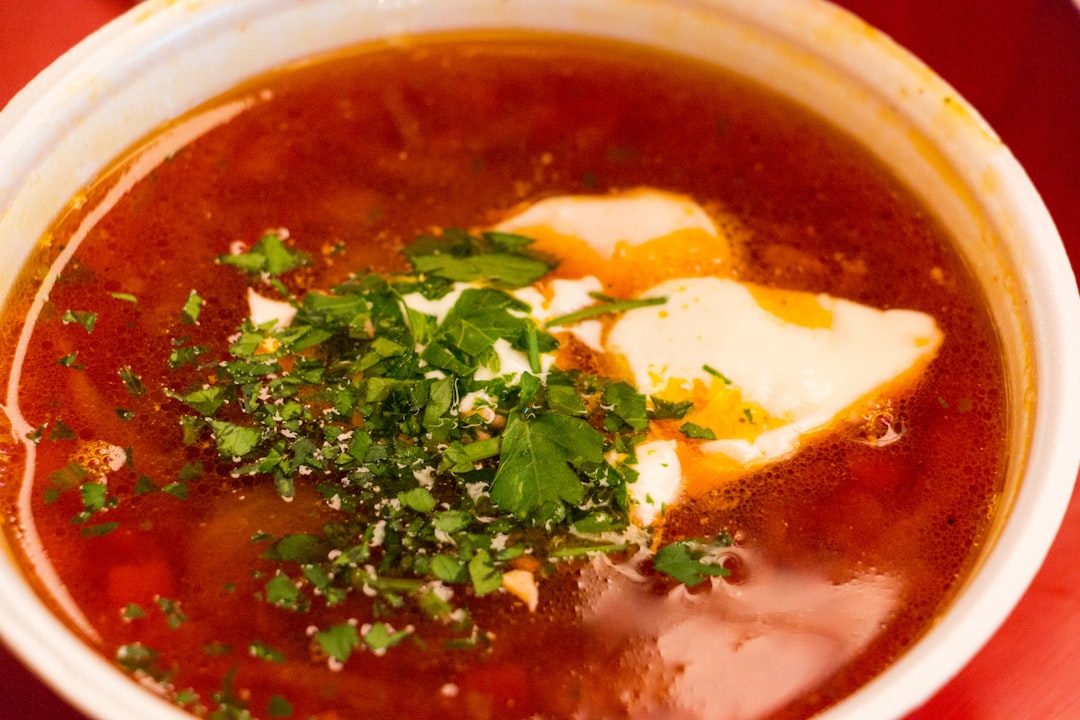Borscht
Borscht is a thick soup made from beets, vegetables, and fermented broth. It is usually served hot with a dollop of sour cream or extra vegetables; however, variations can be served cold as well. The intense flavor of borscht comes from the combination of herbs and spices such as bay leaves, dill, garlic, onions, and pepper. Carrots, cabbage, potatoes, and beef are often added as well.
This versatile soup can be quickly customized with additional ingredients like mushrooms, lentils, and beans to suit individual tastes. Whether you're a borscht purist or more of an experimentalist, there are countless ways to enjoy this hearty dish.
For those who take an interest in history, borscht is an interesting topic to explore. The first written recipe for borscht dates back to 18th-century Ukraine, and since then has been adapted and embraced by countries all over the world as a beloved staple of their cuisine.
Borscht is great for you for several reasons. Packed with vitamins, minerals, and antioxidants, it's filled with nutritious goodness. Plus, because of its low-fat content, it's one of the best meals for those trying to eat healthy. The durability of borscht also makes it an ideal candidate for meal prepping lunches and dinners.
At last, it's time to dig in. Borscht's earthy, savory flavor is an excellent way to satisfy one's appetite. Enjoy it steaming hot in a bowl, topped with a dollop of sour cream, or even as a chilled side for a summer picnic. Whether you're a soup lover or just looking for something a bit different, borscht is sure to hit the spot.
Borscht recipes
Amazing Borscht recipes sourced from the web.
The origin of Borscht
Borscht, a beloved dish that has been around for centuries, is well-loved by many. Its origins, though, remain a bit of a mystery – even to those who love it the most. Despite the spots and splotches on its past, borscht's legacy stands as a testament to its versatility and history.
The earliest documented evidence of borscht dates back to the 16th century in Ukraine when it was served as a soup made from beets, cabbage and other vegetables. While the base ingredients of borscht have remained relatively consistent since its initial conception, the recipe has evolved over the centuries with different countries and cultures adding their own flavors and spices.
In the 17th century, borscht spread to Poland, Belarus, and Russia, where its popularity soared. As recipes were passed down from generation to generation, borscht spread to places like Germany and France, where it took on new flavors and influences.
To this day, borscht is still also a very popular dish in Poland, Ukraine, Belarus, Romania, and Lithuania. It can come in many different varieties, including vegetarian, vegan, spicy or sour. However, the original borscht consists of beets, cabbage, onions, potatoes, carrots, tomatoes, garlic, and dill.
Over the years, borscht has become known for its hearty and tantalizing flavor. It's jam-packed with vitamins and nutrients, making it a healthy and delicious meal for all types of eaters.
Regardless of its ambiguous beginnings, borscht will always remain an important part of the culinary landscape. Its varied flavors, shapes, and colors make it a dish that is appreciated and enjoyed by many. Whether you choose to eat it hot or cold, there's no doubt that borscht will remain a timeless classic.
Types of Borscht
Borscht, the grand staple of Eastern European cuisine, appears in a myriad of shapes and forms across the continent. Whether it's the bright red wave lovingly crafted by Ukrainian grandmothers, or the deep purpley-black cauldrons distilled from Belarusian kitchens, borscht is an indelible part of the region’s culinary heritage.
The traditional Ukrainian version of borscht is made using beets as the star ingredient. It’s spiked with beef, which is cooked alongside carrots, onions, potatoes, and garlic to make a robustly flavored soup. The soup is further thickened by the addition of tomatoes and is then seasoned with an array of flavors, such as bay leaves and black pepper. The end product is a mixture of earthy, umami tastes and vibrant colors that give the dish an iconic appeal.
Other versions of borscht can be found across the Eastern European region. In Latvia, borscht includes a variety of vegetables, including cabbage and turnips, and potatoes are usually left out of the recipe altogether. It’s also common to add mushrooms into the mix, making the dish more complex and interesting.
In Ukraine, borscht is often prepared with a sour cream topping, which gives the soup a creamy texture. Halusky, a type of small dumplings, are sometimes added into the soup at the end of cooking, but this is a practice that varies according to family tradition.
In Belarus, borscht is typically made using a combination of black beets and forest mushrooms, giving the soup an intense flavor and a dark purple hue. It’s usually served with a dollop of savory sour cream, which helps to temper the strong flavors of the earthy ingredients.
The regional variations of borscht reflect the diverse tastes and cooking styles of the people in Eastern Europe. While some recipes are strictly regional, modern chefs have even begun to experiment with their own takes on the traditional soup. From cold borscht salads to pierogi filled with borscht, there’s no limit to what can be done with this timeless classic.


